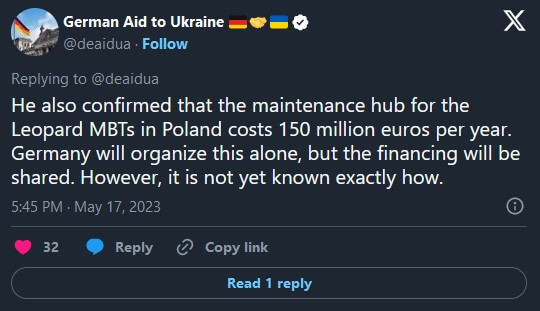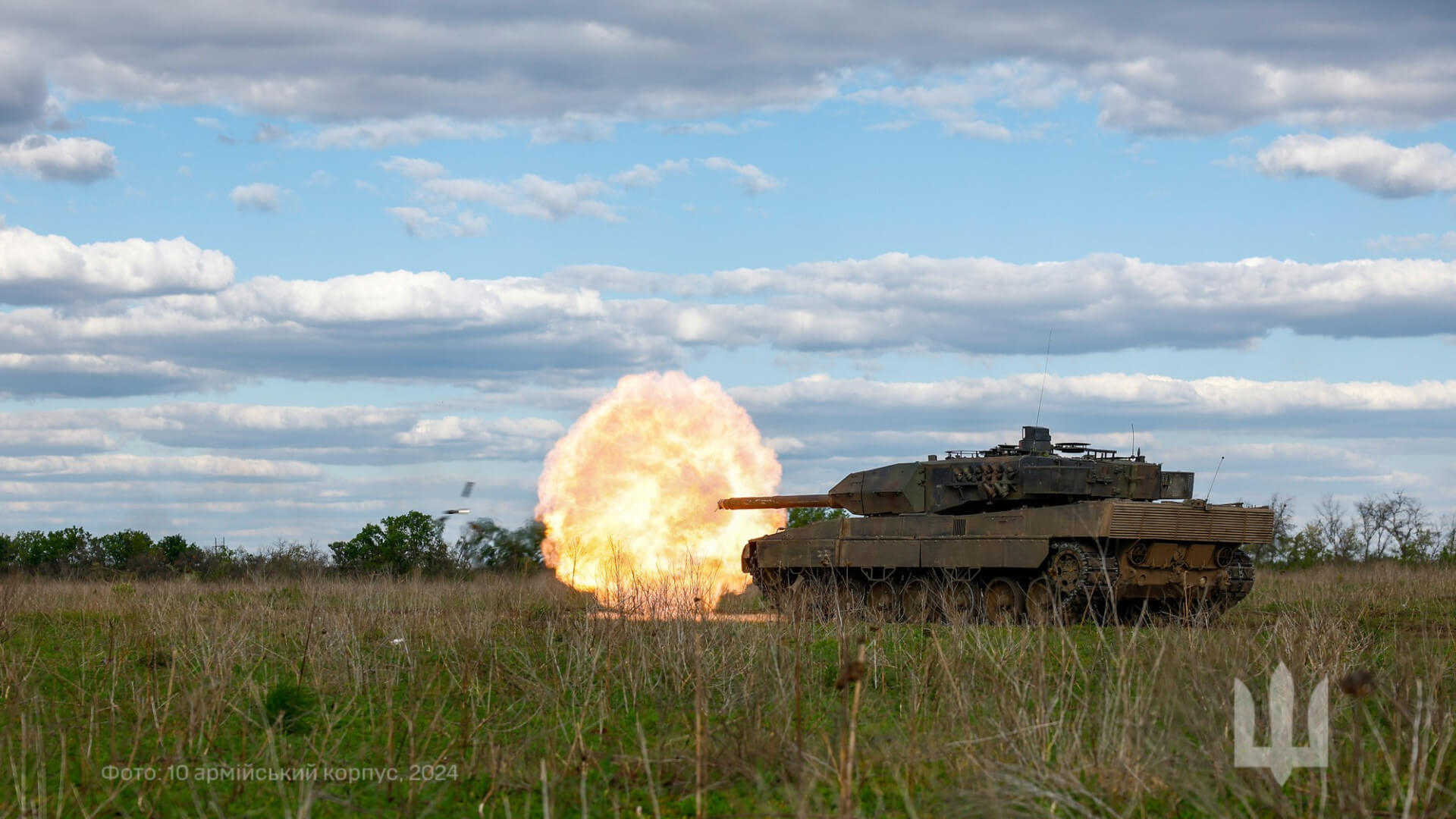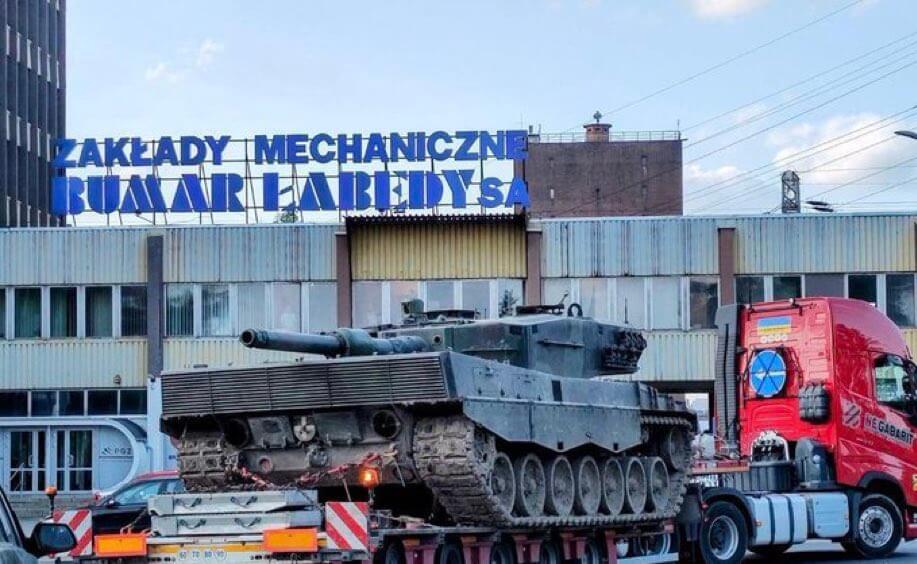Switching from old Soviet equipment to modern Western equipment is supposed to feel to the soldiers like switching from a rusty Lada to a Mercedes-Benz with the smell of a new car. This is exactly how it is with the German “Leopard” MBT.
A coalition of seven different countries delivered the German cat to Ukraine. With a Danish-Dutch delivery of 14 Leopard 2A4s, the number of countries will soon be 9. According to the investigative journalism project Oryxspioenkop, Canada, Germany, Norway, Poland, Portugal, Spain, and Sweden delivered a total of 71 of these main battle tanks, consisting of 21 Leopard 2A6s, 10 Strv 122s alias Leopard 2A5s and 40 Leopard 2A4s.
But even the best tank can be destroyed and needs repairs from time to time. For this reason, Germany and Poland have been working for months on a maintenance hub for the delivered Leopard MBTs.
A memorandum of understanding was signed by the German and Polish Ministers of Defence at the end of April.
The plan was to have the tanks refurbished at two different locations (Gliwice & Posen) in Poland via the Polish arms manufacturer PGZ together with the German arms industry.
While the Polish side was supposed to take responsibility for the infrastructure and a large part of the work, the German side would have taken responsibility for most of the costs. According to the German Minister of Defence Boris Pistorius, these amount to about 150 million euros per year.

The reason this should happen in Poland is obvious. On the one hand, Poland is located directly on the Ukrainian border, which ensures that the tanks can be quickly repaired and brought back, and on the other hand, the infrastructure for the project is already in place in Poland.
What were the problems?
However, the talks dragged on for many months — without success. German industry sources say that PGZ had astronomical price expectations and did not want to give a warranty for possible damage during repairs.
Sources told the German newspaper Der Spiegel that PGZ wanted to charge more than 100,000 euros for the initial inspection (damage diagnosis). In Germany, such a service typically costs only about 12,000 euros. Only a fraction of the Polish price.
PGZ also did not want to give a warranty for possible damage during repairs, which is said to be very unusual. But was that all? A political reason could also have played a role.
To say it mildly, relations between the Polish and German governments are tense, even if at least on the German side they try to show something different to the outside. This starts with World War II reparation demands, continues with a failed Ringtausch which was cancelled by Poland and ends now with the failed Leopard maintenance hub.

Just one day after the news report, German Minister of Defence Boris Pistorius was in Poland to visit his Polish counterpart Mariusz Błaszczak. They gave a joint statement and confirmed the problems in the negotiations, but without giving any reasons. Later, both visited the German soldiers and the Patriot systems that Germany has stationed near the Ukrainian border to protect Polish skies.
Pistorius expressed confidence that the issues would be resolved by the industry negotiators within the next 10 days. An ultimatum, only said in a roundabout way.
Exactly this ultimatum expired. The newspaper Handelsblatt reported on the last day of the NATO summit in Vilnius that the German government is pulling out of the deal because no progress has been made.
According to a spokesperson of the German Ministry of Defence, the repairs on the Leopard 2A6s delivered by Germany and Portugal and Strv 122s delivered by Sweden will be carried out either in Germany or in Lithuania.
He said that maintenance and repairs could begin immediately. The condition for this is that Ukraine notifies the need of repair. Depending on the scale of the work, the industry would then decide whether it would take place in Germany or Lithuania.
Interestingly, however, no work on Strv 122 or Leopard 2A6 has taken place in Lithuania since this announcement. The Lithuanian Ministry of Defence announced during the last Ramstein meeting on X that work on the Leopard tanks could begin in September. So this means that there has been no work there so far.

This means either that no work was necessary, which I do not assume considering the ongoing counter-offensive, or that all work could be done either in Germany or even in Ukraine. But now back to the Leopard 2A4.
At the time, no solution had yet been found for the Leopard 2A4s, although talks were still underway with the Polish side. PGZ had previously revealed that a major point of contention on the Polish side was that the German defence companies were not supplying PGZ with sufficient spare parts.
After the Polish arms manufacturer had emphasised on X that they are still ready to take in Leopard MBTs, repair them and make them combat-ready again, they are now proving that it means business to them.
In the early evening of Saturday the 22nd of July, the Polish Minister of Defence Mariusz Błaszczak posted a picture on X announcing that the reparation centre in Gliwice had started work and that two damaged Leopard 2A4s had already arrived.
PGZ retweeted the Polish minister’s tweet, underlining once again that they keep their word. This is indeed good news. One day later, the German Ministry of Defence confirmed at the Federal Press Conference that the German and Polish industries had reached an agreement.
Both would have agreed to support each other, also in the crucial point “spare parts” mentioned by PGZ. What this means exactly, and what I am sure everyone is most interested in, what costs the German industry is now covering in Poland, was not mentioned.
What can be said is that Germany will most likely bear all the costs for the tanks that they repair and maintain themselves. However, all costs for the Leopard 2A4s would most likely be too much for Poland, so it can be assumed that Germany (and possibly other countries that have supplied Leopard 2A4s) will support Poland financially.
However, it can now be officially said that the Leopard 2A4s, as well as the Strv 122s and Leopard 2A6s, can now be immediately maintained and repaired. Either in Poland, in Germany or in Lithuania.
Why Lithuania?
Bundeswehr troops have been stationed in Lithuania for a long time. For this reason, the local industry should already have far-reaching capacities. Apart from that, the PzH 2000s delivered to Ukraine are being repaired there without any problems.
All’s well that ends well?
While it is very pleasing that — in terms of support for Ukraine — a solution has now been found for the repair of the German-built tanks, one can by no means speak of an ideal solution here.
On the one hand, the German industry would certainly have wished to be less involved in the repair work in terms of labour, and on the other hand, one can assume that the Poles had to make compromises in the end that they actually did not want to make (whether that is fair or not).
The question remains whether everything will now function smoothly, as one imagines. In any case, this would be more than preferable for the sake of Ukraine.
If you liked this post, consider following me on X, Bluesky, or Telegram. If you like, you can also leave me a tip on Ko-fi.
Changelog
- 14th of July 2023 — A statement from the German Ministry of Defence as well as a statement from the Polish arms manufacturer PGZ were included
- 22nd of July 2023 — Added several paragraphs with new information about Leopard 2A4s being repaired now in Poland thanks to a Tweet made by the Polish Minister of Defence
- 24th of July 2023 — Added information from the latest Federal Press Conference
- 20th of September 2023 — Added two paragraphs about the statement by the Lithuanian MoD, that the work on the Leopard tanks can start this month in Lithuania



